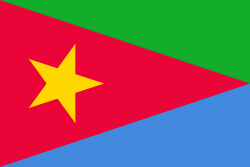Eritrean People's Liberation Front
The Eritrean People's Liberation Front (EPLF) (Tigrinya: ህዝባዊ ግንባር, ህግ, Arabic: الجبهة الشعبية لتحرير إريتريا) was an armed Marxist organization that fought for the independence of Eritrea from Ethiopia. It emerged in 1970 as an extreme left-wing group that split from the Eritrean Liberation Front (ELF). After achieving Eritrean independence in 1991, it transformed into the People's Front for Democracy and Justice (PFDJ), which serves as Eritrea's only legal political party.
 | |
| Chairman | Isaias Afwerki Ramadan Mohammed Nur |
| Founded | 1970 |
| Dissolved | 1994 |
| Split from | Eritrean Liberation Front |
| Succeeded by | People's Front for Democracy and Justice |
| Headquarters | Nakfa, Sahel, Eritrea |
| Newspaper | Vanguard, Sagem and Adulis |
| Youth wing | National Union of Eritrean Youth and Students |
| Armed Wing | Eritrean People's Liberation Army |
| Ideology | Eritrean nationalism Left-wing nationalism Secularism Self-determination Marxism-Leninism (until 1987) Socialism (until 1987) |
| Political position | Far-left (until 1987) |
Background
EPLF and Eritrean Liberation Front first fought during the Eritrean Civil War. In the early 1980s, new armed conflicts between the rival Eritrean Liberation Front led to the front being marginalized and pushed into neighboring Sudan. The EPLF remained the only relevant opposition to Ethiopian occupation in Eritrea.
The EPLF captured many Ethiopian soldiers during the war and kept them in numerous prisoner of war camps, although captured soldiers of the EPLF (of their own) were not afforded the same treatment. These POWs were not harmed by their captors, but instead were indoctrinated about the principles of the EPLF, as well as global politics. Some segments of the EPLF went as far as teaching prisoners of war some trades and skills.[1]
During its protracted struggle the EPLF constructed an underground hospital. In these hospitals surgeries were conducted as well as the production of various pharmaceuticals (the first of its kind made by Eritreans). The front also constructed schools in the rebel areas, as well as underground and partially outdoor schools for the children of the EPLF (i.e. Winna). In 1988, the EPLF started an attack from the northern province of Sahel towards the south. The EPLF emerged as the dominant rebel force as early as 1977 and continued the struggle of the Eritrean War of Independence. In 1991 the EPLF succeeded in the conflict on May 24, 1991.
Battles
Adi Yakob – Embaderho front (Northern front), Adi Hawsha – Sela'e Da'ero front (Southern front), Military Retreat (Soviet intervention; overthrow of Ethiopian Empire by Derg), Ela Beri'ed, Massawa I (Salina salt fields) 1977, Nakfa, Afabet, Massawa II 1990, Ginda'e front, Dekemihare front.
Administration

The First Congress of the EPLF occurred in January 1977 and formally set out the policies of this new organization. At this first meeting a Secretary-General and Assistant Secretary-General were elected and a program adopted. This program specifically targeted a liberalization of women's rights as well as a broad educational policy for maintaining every language and improving literacy. It was also set out that the boundaries of an Eritrean state would be based on the colonial treaties of Italy.
The Second Congress in 1987 brought together the EPLF and the Eritrean Liberation Front/Central Leadership (also sometimes referred to as Central Command, CC) in what was called the Unity Congress.[2] This was the culmination of negotiations over three years which had brought together the two fighting forces in October 1986 under a unified command.[2] On this congress, Isaias Afewerki replaced secretary-general Ramadan Nur. Subsequently, the movement abandoned most of its formerly Marxist–Leninist ideology,[3][4] in favour of an own revolutionary left-wing concept and a more comprehensive and pragmatic approach to unite all Eritrean nationalists.[5]
The Third and last Congress of the EPLF was held in 1994 in Asmara. It was important as it converted the Front from a military organization to a purely political movement. At this Congress, the name of the organization was changed to the People's Front for Democracy and Justice (PFDJ).
References
- Johnson, Michael; Johnson, Trisha (April 1981). "Eritrea: The National Question and the Logic of Protracted Struggle". African Affairs. 80 (318).
- Doris, Burgess; Cliffe, Lionel (Spring 1987). "EPLF Second Congress". Review of African Political Economy. 14 (38): 107. doi:10.1080/03056248708703724. Archived from the original on 2000-09-30. Retrieved 2007-09-07.
- Shinn, David Hamilton; Ofcansky, Thomas P.; Prouty, Chris (2004), "Eritrean People's Liberation Front", Historical dictionary of Ethiopia, Scarecrow Press, p. 143, retrieved 15 January 2012
- Erlich, Haggai (2005), "Eritrean People's Liberation Front", Encyclopaedia Aethiopica, Harassowitz, p. 373, retrieved 15 January 2011
- O'Kane, David; Hepner, Tricia (2011), Biopolitics, Militarism, and Development: Eritrea in the Twenty-First Century, Berghahn Books, p. xx, retrieved 16 January 2011